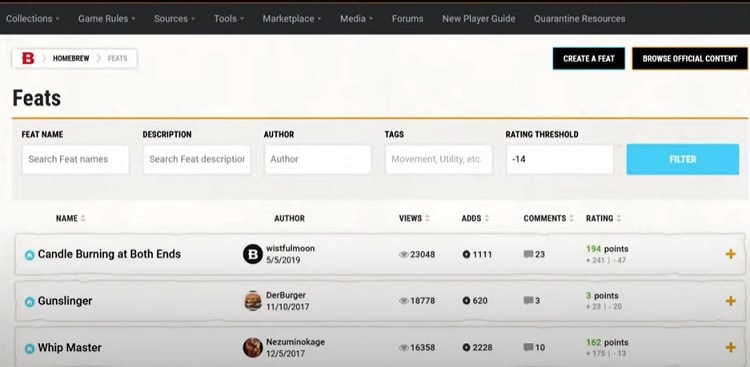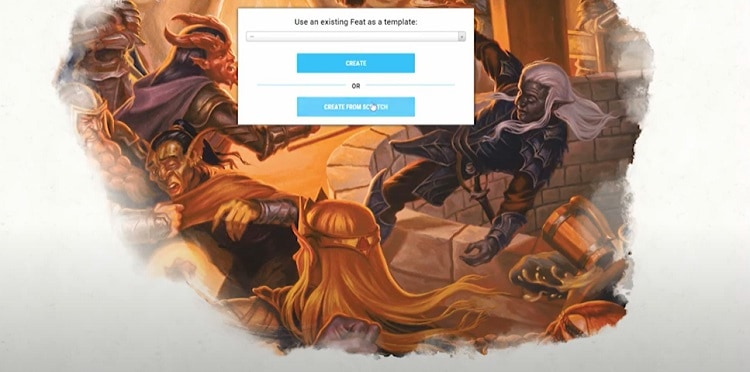There are plenty of ways to make your characters stand out when they are roleplayed during Dungeons and Dragons. How they speak, how they react to challenges, how they take on enemies, and how they deal with their friends.
However, a lot of this comes to your roleplaying, but there are also some ways to differentiate your characters in the game as well. One of these ways is through feats.
The rules for the game states that: A feat represents a Talent or an area of Expertise that gives a character special capabilities. It embodies Training, Experience, and Abilities beyond what a class provides.
So, feats are just extra pieces of flavor that will help to enhance your character. There’s a couple of dozen feats in the base game Player’s Handbook, along with more specialized ones that are included in the official sourcebooks and location guides.
Still, in some cases, those feats are not enough for some DM’s and players, only homebrew content comes in to fill the void! Homebrew feats can add a lot of fun to the game, but they can be tricky to get right if you are playing a game that is concerned with balance.
If you want to add some homebrew feats into the game and make sure that they are balanced and able to be used effectively, then you have found the right guide to 5e Homebrew Feats Ideas!
When Can You Get Feats?

Feats are given to your character at certain levels, and these are generally at levels 4, 8, 12, 16, and or 19. are dealing with a harder campaign. Some feats can also be achieved in place of ability score improvements whenever you level up, so you will need to make that choice when it comes to improving your character’s skills.
Additionally, certain feats are available to everyone, but other feats are available only to certain classes or races. Some even have prerequisite skills or feats you need to take before you can get them.
For example, the Grappler feat allows you to grapple better with your foes but does have a requirement that your strength needs to be at 13 or higher to take it.
Want to know more about Homebrew Classes? Read our complete guide.
What Are Some Examples of Feats in the Base Game?
Some examples of feats from the Player’s Handbook and the various other official sources include:
- Athlete: You have extensive physical training to gain the following benefits: Increase your Strength or Dexterity score by 1, to a maximum of 20. When you are prone, standing up uses only 5 feet of your movement. Climbing doesn’t halve your speed. You can make a running long jump or a running high jump after moving only 5 feet on foot, rather than 10 feet.
- Blade Mastery: You master the shortsword, longsword, scimitar, rapier, and greatsword. You gain the following benefits when using any of them: You gain a +1 bonus to attack rolls you make with the weapon. On your turn, you can use your reaction to assume the parrying stance, provided you have the weapon in hand. Doing so grants you a +1 bonus to your AC until the start of your next turn or until you’re not holding the weapon. When you make an opportunity to attack with the weapon, you have an advantage on the attack roll.
- Linguist: You have studied languages and codes, gaining the following benefits: Increase your Intelligence score by 1, to a maximum of 20. You learn three languages of your choice. You can ably create written ciphers. Others can’t decipher a code you create unless you teach them, they succeed on an Intelligence check (DC equal to your Intelligence score + your proficiency bonus), or they use magic to decipher it.
As you can see, feats tend to fall into several types. Some are purely for roleplaying, others give you new abilities, and some can even increase your ability scores or damage with weapons. While some players min-max and get the best feats regardless of roleplaying, other players tend to pick feats that their character would naturally have.
But what if all those feats aren’t enough for you, well, that’s where homebrew comes in!
Related read: DnD Homebrew Weapon Ideas.
How to Homebrew Feats

There’s actually a ton of homebrew feats that you can find on the internet, and several ways to homebrew your own feats. Perhaps the easiest thing to do is focus on feats from other games and move them into D&D.
Pathfinder is the perfect example, especially since both D&D and both editions of Pathfinder run on the same D20 system. You could also take older feats from the earlier editions of 5e and give them a fresh coat of paint.
Often, it is just a question of balancing and support, because feats are very hard to balance when homebrewed. Even with the low number of feats your character would get in the game, feats have almost infinite possibilities.
So make sure to look for any official or unofficial content that you can answer for your feat if you want to make sure your creation is balanced.
However, if you want to create something completely different and new, then here are some things to consider.
Should my Feat be Big and Flashy?
Some players tend to go a bit crazy with the homebrewed content, making a feat have several effects. It might not break the game, but it can still have a lot of moving parts.
This is good, but some of the best official feats are smaller ones. One that improves your character’s speed by 10, making them faster on the battlefield, or one that gives +1 to damage if you are holding a shield.
These smaller feats might seem underwhelming, but they pack a small and powerful punch that cannot be underestimated at all. So don’t feel like you need to have an absolutely game breaking feat that adds new mechanics or changes to the game, you can do something small and have it be just fine as well.
Think about Your Game Setting
If you are designing feats as a DM, then think about what type of game you are running. Are you running a game focused on survival? War? Exploration in a certain environment?
Make your feats tailored to the games that you are playing, and your players will naturally gravitate towards them. They want an advantage any way they can get one, so if you are playing an artistic game and you give them some homebrewed feats that are designed to increase their artistic survival, then they will go for it.
Of course, you can also make general themed feats as well, focusing on roleplaying or smaller skills. Some feats might allow players to be better at persuasion, understand key bits of lore, or they can just be fun to play due to the background they add.
Talk to Your Players
Finally, before introducing any homebrewed content, you should talk to your players. Or in some cases, your players might even talk to you about what they want for their character. You can share your homebrewed feats and ask for advice or see if any are appealing to them.
Don’t feel offended if they don’t want to grab your homebrewed feats right away, and also don’t make your choices required to play the game.
Your players might even make suggestions or improvements to help both parties have a much better game, and then you can see how your feats work in current gameplay.
Look at Other Types of Feats
All of the feats in any game, whether that’s 5e or Pathfinder, have a pattern to them that you need to replicate. There are also certain types of feats that go into categories, including feats with one large effect, feats with two smaller effects, and feats that give increases to ability scores.
If you are unsure where to start with creating your own feat, then you can get started by using existing ones as a template.
Good Homebrew Feat Ideas

Some feats can be very fun, and the best feats bring our real world skills and abilities into the fantasy world of 5e. For example, one of the feats that has been created already includes the Chef feat:
Time and effort spent mastering the culinary arts have paid off. You gain the following benefits: Increase your Constitution or Wisdom score by 1, to a maximum of 20. You gain proficiency with cook’s utensils if you don’t already have it.
As part of a short rest, you can cook special food, provided you have ingredients and cook’s utensils on hand. You can prepare enough of this food for a number of creatures equal to 4 + your proficiency bonus. At the end of the short rest, any creature who eats the food and spends one or more Hit Dice to regain hit points regains an extra 1d10 hit points.
With one hour of work or when you finish a long rest, you can cook a number of treats equal to your proficiency bonus. These special treats last 8 hours after being made. The creature can use an action bonus to eat one of those treats to gain temporary hit points equal to your Wisdom modifier + your proficiency bonus.
There’s no reason you couldn’t include a feat like: Architect, accountant, coachman, or gardener. All of these real world jobs can easily be translated into a fantasy world, and it can be fun to give your character a job as a backstory and have their feat give them abilities that match that.
It’s one thing to say your half-orc was a chef, and another for that character to have the chef trait that allows them to use their abilities.
You can also have feats related to a character’s past as well. If a Dwarf was raised by Elves in the wilderness, he might have an ‘elf touched’ feat that helps to reflect that by giving him some of the elven racial abilties.
5e Homebrew Feats Ideas FAQs
Question: Do My Feats Need Prerequisites?
Answer: In most cases, prerequisites for feats aren’t needed unless something is needed to benefit from the feat. For example, the Elemental adapt feat requires the character to be able to cast at least one spell, because non-spellcasters can’t use it.
Also, you can look at the story of the feat as well. For example, if you have a feat that is called ‘Artful Dodger’ that gives a 25% chance for any ranged attack against the character to miss, they might need to have proficiency in Acrobatics because it makes sense that someone who is a good acrobat can dodge objects flying towards them.
Question: What if my Players Have Feat Ideas?
Answer: Some players tend to get really ingrained in Their character and que includes making feats for what Their characters might naturally be good at. For example, a character with a law and order background might have a feat that gives them unfettered access to local law enforcement where they have a reputation.
If your players come to you with feat ideas or reskins, then have a conversation with them. Ask them why they came up with the feat that they did, and work with them to make any changes you need to be made for balance. Unless a feat is horribly broken, there’s no reason why you wouldn’t be able to incorporate them into your game.
Question: Do I Need Feats?
Answer: Homebrew or otherwise, feats are an optional rule. They can be used by players and DMs to give more customization, flavor, and roleplay skills to characters. However, being able to score increases and clever roleplaying can do the exact same thing, so feats aren’t entirely required.
It’s up to the table if they want to include feats, leave certain feats out of the game, or introduce homebrew feats into the world. Feats are a fun and infinitely customizable part of D&D, and whether you reskin old feats or create new ones, they will enhance your game.
- DnD Demons Guide: What Are Demons in 5e? - September 18, 2021
- Detect Thoughts 5e Guide: When, Why and How to Use It - September 9, 2021
- The Ultimate DnD Toll the Dead 5e Guide - September 9, 2021

